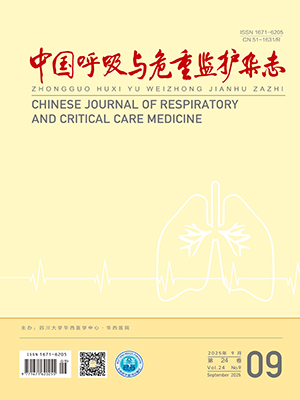| 1. |
Ricard JD. High flow nasal oxygen in acute respiratory failure. Minerva Anestesiol, 2012, 78(7): 836-841.
|
| 2. |
吕姗, 安友仲. 主动温湿化的经鼻高流量氧疗在成人患者中的应用. 中华危重病急救医学, 2016, 28(1): 84-87.
|
| 3. |
沈佳伟, 安有仲. 拔除气管导管后患者的经鼻高流量吸氧治疗. 中华危重病急救学, 2017, 29(1): 84-88.
|
| 4. |
吴丽娟. 关注呼吸衰竭治疗的新技术—加温加湿经鼻高流量氧疗. 中华医学杂志, 2017, 97(5): 321-324.
|
| 5. |
Ni YN, Luo J, Yu H, et al. Can high-flow nasal cannula reduce the rate of endotracheal intubation in adult patients with acute respiratory failure compared with conventional oxygen therapy and noninvasive positive pressure ventilation? A systematic review and meta-analysis. Chest, 2017, 151(4): 764-775.
|
| 6. |
徐晓翠, 王金柱, 姚惠萍. 经鼻高流量湿化氧疗对 COPD 患者拔管后再插管及呼吸衰竭的影响. 齐鲁护理杂志, 2018, 24(5): 1-3.
|
| 7. |
韩晓霖, 刘述平, 刘一诚, 等. 经鼻高流量氧疗对 AECOPD 患者撤机效果的影响. 湖南师范大学学报(医学版), 2018, 15(1): 145-148.
|
| 8. |
杨毅, 刘楠, 候晓彤, 等. HFNC 与 NPPV 对于心外科术后低氧血症患者的疗效研究. 首都医科大学学报, 2016, 37(5): 664-671.
|
| 9. |
耿希华. 经鼻高流量湿化氧疗系统在心胸外科术后急性呼吸衰竭患者中的应用. 山东医药, 2016, 56(45): 94-96.
|
| 10. |
王伟. 经鼻高流量湿化氧疗与文丘里面罩氧疗对拔管后患者的干预效果比较. 临床肺科杂志, 2017, 22(9): 1566-1569.
|
| 11. |
王大鹏, 聂晓伟, 潘红, 等. 经鼻高流量湿化氧疗治疗肺移植术后移植物失功患者的临床研究. 现代生物医学进展, 2017, 17(34): 6709-6712.
|
| 12. |
李志伟, 李超, 董权, 等. 经鼻高流量氧疗与无创通气治疗腹部外科术后患者脱机后低氧血症的临床疗效比较. 昆明医科大学学报, 2017, 38(1): 65-69.
|
| 13. |
张京臣, 吴逢选, 孟琳琳, 等. 慢性阻塞性肺疾病患者拔管后序贯经鼻高流量氧疗的效果及安全性. 中华医学杂志, 2018, 98(2): 109-112.
|
| 14. |
王逸峰, 戴幼竹, 严洁. 湿化高流量鼻导管氧疗在慢性阻塞性肺疾病急性加重期气管插管机械通气患者撤机拔管后的应用效果. 实用心脑肺脑血管杂志, 2017, 25(8): 155-157.
|
| 15. |
Song HZ, Gu JX, Xiu HQ, et al. The value of high-flow nasal cannula oxygen therapy after extubation in patients with acute respiratory failure. Clinics (Sao Paulo), 2017, 72(9): 562-567.
|
| 16. |
Yoo JW, Synn A, Huh JW, et al. Clinical efficacy of high-flow nasal cannula compared to noninvasive ventilation in patients with post-extubation respiratory failure. Korean J Intern Med, 2016, 31(1): 82-88.
|
| 17. |
Dhillon NK, Smith EJT, Ko A, et al. Extubation to high-flow nasal cannula in critically ill surgical patients. J Surg Res, 2017, 217: 258-264.
|
| 18. |
Fernandez R, Subira C, Frutos-Vivar F, et al. High-flow nasal cannula to prevent postextubation respiratory failure in high-risk non-hypercapnic patients: a randomized multicenter trial. Ann Intensive Care, 2017, 7(1): 47.
|
| 19. |
Stéphan F, Barrucand B, Petit P, et al. High-flow nasal oxygen vs noninvasive positive airway pressure in hypoxemic patients after cardiothoracic surgery: a randomized clinical trial. JAMA, 2015, 313(23): 2331-2339.
|
| 20. |
Maggiore SM, Idone FA, Vaschetto R, et al. Nasal high-flow versus Venturi mask oxygen therapy after extubation. Effects on oxygenation, comfort, and clinical outcome. Am J Respir Crit Care Med, 2014, 190(3): 282-288.
|
| 21. |
Hernández G, Vaquero C, González P, et al. Effect of postextubation high-flow nasal cannula vs conventional oxygen therapy on reintubation in low-risk patients: a randomized clinical trial. JAMA, 2016, 315(13): 1354-1361.
|
| 22. |
Brotfain E, Zlotnik A, Schwartz A, et al. Comparison of the effectiveness of high flow nasal oxygen cannula vs. standard non-rebreather oxygen face mask in post-extubation intensive care unit patients. Isr Med Assoc J, 2014, 16(11): 718-722.
|
| 23. |
Corley A, Bull T, Spooner AJ, et al. Direct extubation onto high flow nasal cannulae post-cardiac surgery versus standard treatment in patients with a BMI ≥30: a randomised controlled trial. Intensive Care Med, 2015, 41(5): 887-894.
|
| 24. |
Hernández G, Vaquero C, Colinas L, et al. Effect of postextubation high-flow nasal cannula vs noninvasive ventilation on reintubation and postextubation respiratory failure in high-risk patients: a randomized clinical trial. JAMA, 2016, 316(15): 1565-1574.
|
| 25. |
Futier E, Paugam-Burtz C, Godet T, et al. Effect of early postextubation high-flow nasal cannula vs conventional oxygen therapy on hypoxaemia in patients after major abdominal surgery: a French multicentre randomised controlled trial (OPERA). Intensive Care Med, 2016, 42(12): 1888-1898.
|
| 26. |
陈荣昌, 主编. 呼吸与危重症医学. 北京: 人民卫生出版社, 2017, 325-326.
|
| 27. |
朱蕾, 钮善福, 主编. 机械通气. 上海: 上海科学技术出版社, 2016, 45-49.
|
| 28. |
American Association for Respiratory Care, Restrepo RD, Walsh BK. Humidification during invasive and noninvasive mechanical ventilation: 2012. Respir Care, 2012, 57(5): 782-788.
|
| 29. |
王丽娟, 夏金根, 杨晓军, 等. 成人经鼻高流量氧气湿化治疗的应用进展. 中华结核和呼吸杂志, 2016, 39(2): 153-157.
|
| 30. |
Sztrymf B, Messika J, Bertrand F, et al. Beneficial effects of humidified high flow nasal oxygen in critical care patients: a prospective pilot study. Intensive Care Med, 2011, 37(11): 1780-1786.
|
| 31. |
Corley A, Caruana LR, Barnett AG, et al. Oxygen delivery through high-flow nasal cannulae increase end-expiratory lung volume and reduce respiratory rate in post-cardiac surgical patients. Br J Anaesth, 2011, 107(6): 998-1004.
|
| 32. |
Coudroy R, Jamet A, Petua P. High-flow nasal cannula oxygen therapy versus noninvasive ventilation in immunocompromised patients with acute respiratory failure: an observational cohort study. Ann Intensive Care, 2016, 6(1): 45-48.
|
| 33. |
Papazian L, Corley A, Hess D, et al. Use of high flow nasal cannula oxygenation in ICU adults: a narrative review. Intensive Care Med, 2016, 42(9): 1336-1349.
|
| 34. |
Nishimura M. High-flow nasal cannula oxygen therapy in adults. J Intensive Care, 2015, 3(1): 15.
|




